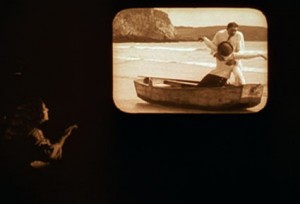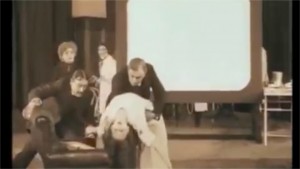By Juliet Wagner (Regular Contributor)
Audiences in the twenty-first century are very familiar with the filmic convention of the “flashback.” Most often, flashbacks serve to fill the viewer in on a character’s past, and sometimes form an integral part of the structure of the narrative (in series like Lost and Orange is the New Black, for example). In the psychological domain, however, “flashbacks” are usually associated with negative experiences and suppressed memories that return uninvited. In many films –war films especially—both types of flashback are combined: hazy, point-of-view shots take us inside the mind of a traumatized protagonist and offer us a film-within-a-film, a visual representation of their internal rewind and replay.
Kador Cliffs
The association between film and memory is as old as cinema, and the silent film director Léonce Perret’s movies offer a particularly intriguing early example. Perret (1880 – 1935) was trained as a theatre actor, but was quick to recognize the potential of cinema and is praised today for his innovative shot composition and editing. In more than one film, he explored the potential of film to capture and restore memory in traumatic circumstances. This trope is most pronounced in the film he directed in 1913 for Gaumont, Le mystère des roches de Kador, marketed in English-speaking countries as Kador Cliffs.
After the attempted murder of her lover by her villainous uncle and a narrow escape on boat, the heroine of the film, Suzanne, collapses and awakes traumatized with no memory of the events that transpired. In an attempt to help cure her, Suzanne’s lover Jean consults “Dr. Williams” (Anglophone in the original French intertitles too), who agrees to film and screen a reconstruction for the amnesiac heroine in order to restore her memory. As the doctor speaks to a white-coated assistant, Jean casts his eyes to Williams’ publication, and the audience sees the close-up of a printed text that exclaims, of cinema: “The wonderful invention recently adopted in mental medicine is of extreme importance.”
Jean-Martin Charcot’s legacy
In a scene remarkably redolent of Charcot’s clinic, we see the disorientated Suzanne – in a long white gown, with her dark her loose– approach the screen depicting the incidents at Kador Cliffs (the film within the film). She is drawn towards it, illuminated by the light of the screen. After obvious emotional turmoil, she turns and collapses into the arms of the observing medical attendants. She then comes to and recognizes Jean, her memory fully restored. The climax of the film is resolved by a film.
What is striking about this early “flashback” scene, aside from its imagery, is that the “flashback” is external to Suzanne. Cinema had a special relationship to memory through its physiological, hypnotic effect rather than through its psychological content. This reflects a conviction about the bodily nature of emotion that was central to the contemporary understanding of both trauma and film at the outbreak of the First World War. Flashbacks in silent cinema encapsulated the medical and cultural attitudes of their time, and have evolved as a filmic and narrative device along with attitudes to trauma.
For more on Léonce Perret and his work, see:
Daniel Taillé, Léonce Perret. Cinématographiste (Niort: Association “Cinémathèque en Deux-Sevres”, 2006)


